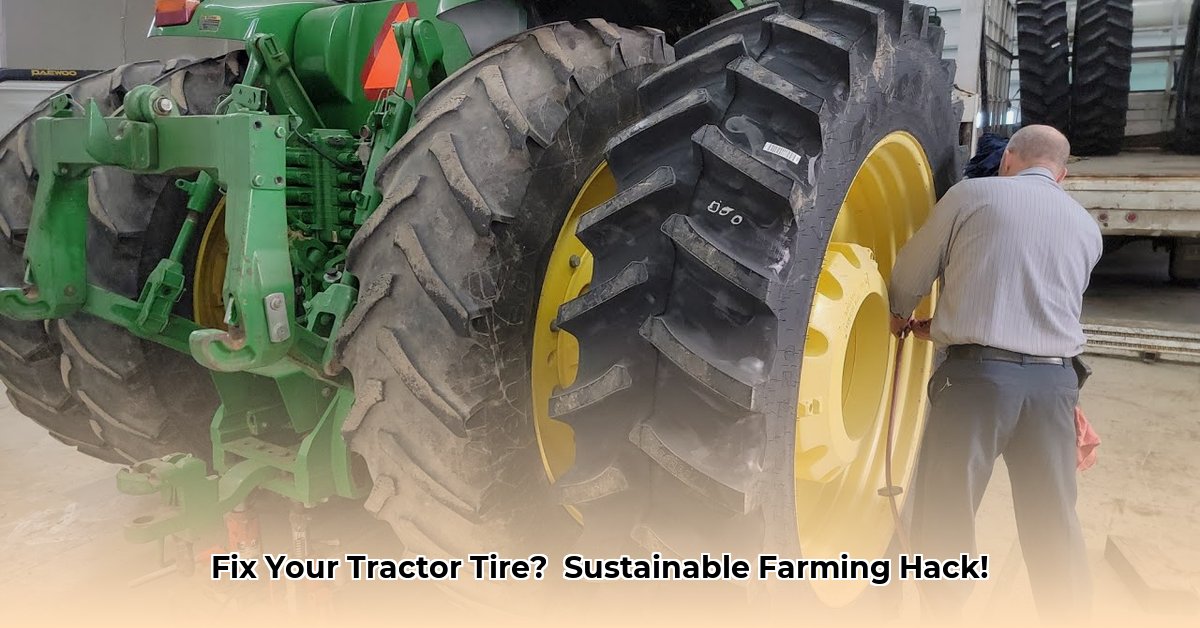
Changing a tractor tire can seem intimidating, but with careful steps and the right tools, it's a manageable task. This guide provides clear, concise instructions for safe and efficient tire replacement, emphasizing sustainable practices. For additional tire repair solutions, check out this helpful resource: tractor tire repair.
Assessing the Damage: Repair or Replace?
Before starting, thoroughly inspect the tire. Is the damage a repairable puncture, or does it require a complete replacement? Note the tire's size and type for ordering a replacement. Crucially, ensure your tractor is parked on level ground, away from obstacles, with the parking brake firmly engaged. Don't proceed if you're unsure about the extent of the damage – consult a mechanic.
Gather Your Gear: Essential Tools and Safety Equipment
The right tools are essential for a smooth and safe process. You'll need:
- Tire-changing tools: A heavy-duty lug wrench, a jack with sufficient weight capacity for your tractor (check the specifications!), and wheel chocks (absolutely vital for safety).
- Replacement tire: Purchase an exact match for size and type to avoid mechanical problems.
- Safety gear: Heavy-duty gloves to protect your hands and safety glasses to shield your eyes from potential debris.
- Wheel weights (if needed): Essential for balancing the new tire after installation. An unbalanced tire leads to vibrations, uneven wear, and a rough ride.
- Air compressor or pump: A high-capacity pump suitable for tractor tires is required for inflation.
- Optional but recommended: Lifting straps offer additional security when working under the tractor.
Step-by-Step Tire Replacement Guide
Follow these steps meticulously for a successful and safe tire change:
- Secure the Tractor: Place wheel chocks firmly against the wheels opposite the one you're changing. This prevents accidental movement, even on level ground.
- Loosen Lug Nuts: Slightly loosen the lug nuts while the wheel is still on the ground. This is easier than doing it while the wheel is in the air.
- Jack It Up: Carefully jack up the tractor until the damaged wheel is clear of the ground. Crucially, immediately place jack stands under the axle to secure the tractor before proceeding. Never work under a tractor supported solely by a jack.
- Remove the Wheel: Once securely supported, remove the lug nuts and gently pull off the wheel. Be prepared; it will be heavy.
- Mount the New Tire: Carefully mount the new tire onto the wheel hub, ensuring it seats correctly. A properly seated tire is critical for safety and performance.
- Tighten Lug Nuts: Tighten the lug nuts using a star pattern (opposite nuts in sequence) to avoid warping the wheel. Gradually increase torque.
- Lower Slowly: Carefully lower the tractor using the jack, ensuring the tire remains aligned.
- Final Tightening: Once the tire touches the ground, give the lug nuts a final, very firm tightening.
- Inflate: Inflate the new tire to the manufacturer's recommended pressure (found on the tire sidewall). Use a reliable pressure gauge.
- Balance (If Possible): If you have access to a wheel balancer, use it to ensure smooth operation and prolonged tire life.
Tube or Tubeless: Choosing the Right Tire for Sustainability
Tubeless tires generally offer longer lifespan and better fuel efficiency, aligning with sustainable farming practices. However, tubeless tire repairs are more complex and might require professional assistance. Tube-type tires are easier to repair but have shorter lifespans and lower fuel efficiency. The optimal choice depends on your skills and resources.
Tire Pressure: A Small Detail with a Big Impact
Correct tire pressure is critical. Underinflation increases fuel consumption and soil compaction, while overinflation reduces traction and can damage the tire. Regularly check and adjust pressure per the manufacturer's recommendations. Isn't optimizing tire pressure vital for both your tractor's efficiency and the health of your soil?
Thinking Green: Sustainable Tire Practices
Sustainable farming extends beyond tire replacement. Explore recycling programs for old tires and consider tires made from recycled or sustainable materials. Proper tire maintenance and responsible disposal are key elements of environmentally conscious farming. Don't you agree that responsible tire management contributes to a more sustainable future?
Troubleshooting Common Issues
Here's a quick guide to address common problems:
| Problem | Solution |
|---|---|
| Stuck Lug Nuts | Use a breaker bar or impact wrench. |
| Tire Won't Seat Properly | Thoroughly clean the wheel hub of any debris. |
| Slow Leak | Inspect for punctures and repair with a patching kit. |
Remember, safety is paramount. If you encounter difficulties, consult a qualified mechanic. Proper tire maintenance is an investment in the efficiency and sustainability of your farm.